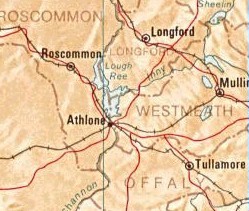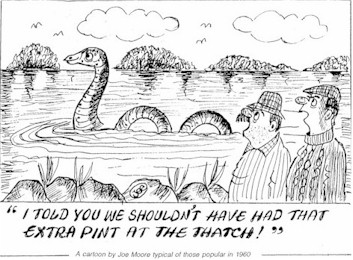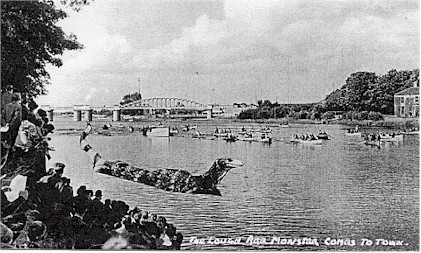Lough Ree may be the most
recognized amongst Irish 'monster-haunts' but few seem to realize how
ancient the tradition actually is. A passage in Life of St.
Mochua of Balla tells of a hunting party refusing to pursue a stag
that had fled to an island on account of "a horrible monster
that infested the lake, and was accustomed to destroy
swimmers." One hunter decided to chance a swim and arrived on
the island without incident, but "as he was returning the beast
devoured him."
Indication of a 20th century
monster in Lough Ree were seemingly blank blank until one well
publicized incident broke what had otherwise been an informal code of
silence. The incident in this case is perhaps the most famous of
all Irish reports as it involved a total of three witnesses whose
vocation elevated the issue of credibility to a new
height.

Father Quigly, Father
Murray and Father Burke were all familiar with Lough Ree and at the time
fishing off Holly Point. It was 9:30pm on May 18, 1960 on a warm
summery evening when one of them pointed towards an unusual object about
100 yards away exclaiming, "Do you see what I
see?"
"Lough
Ree Monster Sighted!"
The Westmeath Independent
broke the story on May 28th, 1960 with front-page headlines reading
"Lough Ree Monster Sighted!" In an interview with one of the
paper's senior reporters one of the priests stated the
following:
"It was moving.
It went down under the water and came up again in the form of a
loop. The length from the end of the coil to the head was 6
feet. There was about 18 inches of head and neck over the
water. The head and neck were narrow in comparison to the
thickness of a good-sized salmon. It was getting its propulsion
from underneath the water, and we did not see all of
it."

A
drawing of the animal by one of the priests.
(© Peter Costello
In Search of Lake Monsters 1974)
The testimony of
three clergymen was more than enough to create a local stir which
quickly poured out from Athlone and seized the attention of the
country's leading newspapers. After the BBC caught wind of the
matter the story went international appearing in multiple
languages.
Letter to the Inland Fisheries Trust:
"....its identification poses a most
interesting problem."
Recognizing
the importance of their observation the trio submitted a detailed report
to the Inland Fisheries Trust:
There were
two sections above the water; a forward section of uniform girth,
stretching quite straight out of the water and inclined at the plane
of the surface at about 30 °, in length about 18-24 inches.
The diameter of this long leading section we would estimate to be
about 4 inches. At its extremity which we took to be a
serpent-like head, it tapered rather abruptly to a
point.
Between the leading and the
following sections of this creature, there intervened about two feet
of water. The second section seemed to us to be a tight,
roughly semi-circular loop. This portion could have been a
hump or a large knob on the back of a large body under the surface
that was being propelled by flippers. As to the dimensions of
this section, if a loop we should say the girth of a large fifteen
pound salmon; if however, a round hump. . . we should put its base
at about 18 inches. . . We would estimate the overall length to the
two visible sections, measured along the surface from tip of snout
to end of hump, at about 6 feet.
The
movement along the water was steady. There was no apparent
disturbance of the surface, so that propulsion seemed to come from a
well-submerged portion of the creature. There was no
undulation of its body above the water. It was cruising at a
very leisurely speed, and was apparently unconcerned about our
presence. We watched it moving along the surface for a period
of two or three minutes in a north-easterly direction. It was
going towards the shore; then it submerged gradually rather than
dived, and disappeared from view completely. Another couple of
minutes later it reappeared still following the same course. . . It
reached a point 30 yards offshore, where it submerged and we saw it
no more.
Elsewhere in the letter it
was stated:
"One ought
not, of course, to assume that the answer to the problem is some
completely unknown creature....nevertheless we are in this case
convinced that what we saw was not a pike or otter, or any other
fish or animal familiar to us, nor was it some inanimate object such
as a tree branch carried by a current in this part of the lake....
We were convinced that what we saw was a living creature and we feel
that its identification poses a most interesting
problem."
Despite the
optimism and excitement surrounding the prospect of Ireland boasting its
own counterpart to the Loch Ness Monster, not even priests were immune
from the all too predictable onslaught of debunkment. Listed
amongst the various and sometimes colorful explanations were
inline-swimming otters, a row of ducks or a configuration of several
pike entangled upon a hook line.

Stories
Begin to Surface
While some sought
to slay the Lough Ree creature as a case of misidentification, it didn't
take long for locals to break their long silences on the matter and step
forward with experiences of their own.
One such report
told of two men who one evening were walking along the shore at St.
Mark's Bay when they saw what appeared to be calf swimming in the
lake. It had a raised neck about a foot above the water (this
alone disqualifies a calf as they cannot hold their necks out while
swimming) followed by a black hump. After rushing out on boat to
save the calf, the animal submerged.
In Charts of the
River Shannon amongst an area of 70 feet deep water a spot is
labeled "unidentified snag". The cause for this curious marking is
the result of a cabin cruiser striking an unidentified object in
mid-channel. The spot was later dragged but nothing was
found.
Paddy Hanley, a retired
postman, added his own experience to the growing collection of reports
in Lough Ree. His experience took place a full 30 years prior to
the priests' sighting. While fishing north of Yew Point at the
mouth of Bally Bay, something powerful took his line. In a
somewhat ironic twist, because he was using the strongest fishing line
available on the market at the time ("like a rope") Hanley found himself
being towed about the lake until finally severing the line.
According to Mr. Hanley such a strange occurrence had been claimed by
other fishermen on the
lough.
Joining Hanley's account is
F.J. Walters who told that while fishing off Beam Island he'd hooked
something using a heavy line. The 'thing' dived rapidly towards
the bottom, using up the 70 feet of line before snapping. Such
speed, Walters noted, was impossible for any
fish.
In 1958 two lucky English tourists
reportedly had their own experience on the Lough Ree Monster Ride as
they were dragged across the lake upon hooking something until one
finally cut the line.
Two
months prior to the priests' sighting a pair of fishermen, Patrick
Ganley and Joseph Quigly, fought with something large that had entered
their pike net. Though they couldn't quite make out what it was
the creature's thrashing reportedly sending up columns of water six feet
in the air. It was "strong as a horse" and after finally escaping
left a nine-foot hole in the relatively new net.
COSTELLO, Peter In Search Of Lake Monsters
(p.136-141) [Berkley Medallion Books 1974]

Lough Ree 2001
For five days in
June of 2001 a three-man team representing GUST (Global Underwater
Search Team) conducted an "expedition" into Lough Ree searching for
any indications of current lough monster presence through surface
monitoring and the deployment of a hydrophone. The team consisted of
GUST leader and founder Jan Sundberg of Sweden along with Espen
Samuelsen of Norway and myself, at the time on leave from the U.S.
Marines.
Two events
transpired that were later announced as to have possible relevance to
the Lough Ree Monster. One was a peculiar sound Jan detected
with the hydrophone that he stated as being quite similar to sounds
heard on previous expeditions in Norway. The second was an
observation had by Jan and briefly noticed by Espen, involving a
small, dark tube-like object seen swimming away from a small
island. The object was being propelled by something beneath the
surface.
During our time in
and around Athlone I tried my best at asking locals what they recalled
as far as stories sightings in the lake. The response always
defaulted to the famous sighting by the priests but I acquired an
impression that most were assuming we knew more about the matter than
they did and therefore didn't know what else they could
contribute. Eventually one lakeshore resident mentioned
something about a story that had been circulating during the 1970s
regarding a sighting of an animal swimming like a dolphin near
a lakeside hotel.
On a later
occasion while socializing at a resort's pub someone referred to a
particular time when either American or Canadian tourists had come
ashore from a boat trip thinking that they'd encountered a snapping
turtle. Apparently something below the surface had seized an oar
in its jaws. The behavior was deemed as unlikely for a pike but
at the same time there are no known native turtles in Ireland leaving
question as to exactly what kind of animal had bit the
oar.
Midland Water-Horse?
Not until the
final evening of my stay (Jan and Espen were to continue for a few
more days) did it became apparent my inquiries themselves were
misguided. While out on the lake with a local acquaintance we'd
made I asked if he was familiar with the term water-horse. Previously
he'd commented that all he had ever heard of the Lough Ree Monster was
regarding the sighting by the three priests. But in reference to
"water-horse" his response was quite unexpected. He stated that
growing up they'd heard of folks seeing them in parts of the
lake but had assumed they were mistaking cattle swimming from the
islands. That very well may have been the case but what's
significant here is how the term "water-horse" was deemed so
distinctive that it failed to register within inquiries regarding
"lake monsters." How many others would have likewise been able
to recall stories from past years of water-horse sightings but
otherwise were unfamiliar with reports of a "monster"?
The
otherwise absence of recent reports does not necessarily imply an
absence of recent sightings. Still, even with the consistent
media attention centered on the GUST "expedition" it would appear that
no new sightings were brought forward despite the inviting
atmosphere. At least none that we came to hear of.

Postcard reads: The Lough Ree Monster Comes To
Town
Peistes@Yahoo.com
